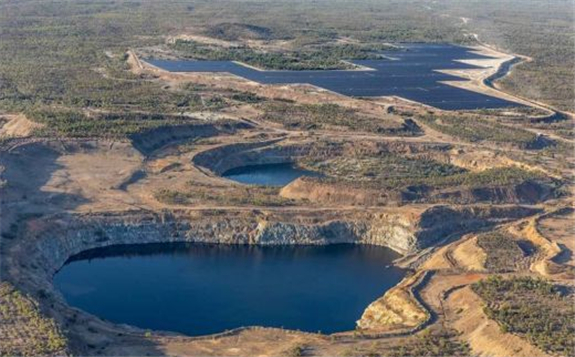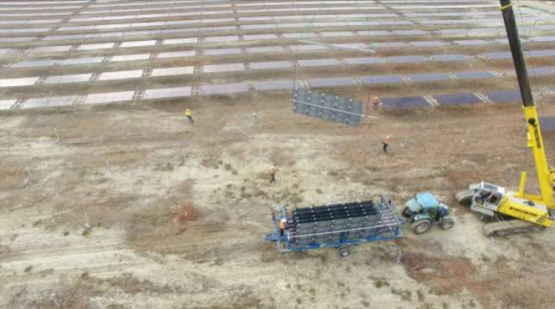
A pumped hydro energy storage (PHES) project at a former gold mine in Queensland, Australia which would be able to store 250MW of power for up to eight hours has raised significant funding in the past few days.
On 24 March, the Australian Renewable Energy Agency (ARENA) said that conditional approval has been given for AU$47 million (US$35.95 million) of ARENA funding to support the 250MW / 2,000MWh Kidston Stage 2 PHES project. The plant is being developed by Genex Power, an Australian Stock Exchange-listed (ASX-listed) power generation development company, which on 26 March then said that it had also already raised AU$56 million in two days from an equity raise effort.
The project involves repurposing the former gold mine site into an emissions-free large-scale energy storage system, turning two existing pits at the mine into lower and upper reservoirs for water to be stored in. Dropping water from the upper to lower reservoir drives turbines to generate power during peak times, at off-peak times, cheaper electricity imported from the National Electricity Market (NEM) will be used to pumped the water back up through the system’s reversible turbines.
The entire project includes the building of a 275kV single circuit transmission line from the mine site in Kidston to Mount Fox, around 190km away towards the northeast coast. A new electrical substation will also be built at Mount Fox, connected the PHES plant to the NEM.
The system will be colocated with a solar PV plant with 50MW capacity that Genex Power has already built at the site. Genex is also planning a 150MW wind project, Kidston Stage-3 Wind and another 270MW of solar, the Kidston Stage-2 Solar project for the site. The pledged transmission infrastructure buildout would also support interconnection for those two facilities.
An energy off-taker has already been found for the pumped hydro plant, utility EnergyAustralia, and an EPC contractor appointed. Construction is expected to be finished by 2024, with the construction phase creating around 500 jobs and another 20 permanent roles to be created to operate the plant once it is up and running.

Financing closing in on AU$777 million total cost target
The entire project — including the transmission network buildout — is expected to cost around AU$777 million. Developer Genex is receiving up to AU$610 million in debt equity pledged in 2019 towards that cost from the Northern Australia Infrastructure Facility (NAIF), a AU$5 billion Commonwealth Government lending facility set up to support economic and population growth and development in the Northern Territory, Queensland and Western Australia states.
In February, Genex announced to the ASX that the Queensland Government committed AU$147 million in funding towards the building of the transmission line, which is expected to create around 400 jobs during its construction. That funding went directly to Powerlink Queensland, the company which will build, own and operate the transmission line.
ARENA’s latest pledge of funding comes on top of a smaller amount committed by the agency early on to support feasibility studies for the project in 2016. Meanwhile, Genex Power launched its equity raise for AU$90.3 million the same day the ARENA funding was announced. The first phase was a placement and institutional entitlement offer, and following that quick AU$56 million raise, the company is opening a retail entitlement offer today (30 March) worth AU$34.2 million. Japanese electric utility company J-POWER will be a shareholder along with Genex and is raising equity also.
First new project in 37 years could be accompanied by others
A 2017 study by the Australian National University found that there were nearly 20,000 potential sites in the country where large-scale pumped hydro could be developed, across New South Wales, Victoria, Western Australia and the Northern Territory.
While the vast majority of the world’s existing energy storage facilities are still pumped hydro plants mostly built many decades ago — the US has around 28GW of pumped hydro compared to about 2GW of lithium-ion battery storage — getting new pumped hydro projects built is not easy.
The need for an appropriate location with two large bodies of water, one above the other and the high initial capital cost are among the reasons for this, although once built, the plants are very cheap, economical and environmentally-friendly to operate.
Last year, in a blog for this site, Kowtham raj VS, a member of Indian government innovation think tank NITI Aayog noted that the lowest cost renewables-plus-storage tariff in history was bid in a tender hosted by the Solar Energy Corporation of India (SECI) by a developer planning a large-scale pumped hydro plant with solar.
“The pumped storage technology has very long and predictable lifetimes which socialises the capital investment over a few decades. The number one challenge in pumped storage is site availability. If an excellent water pumpable site is available, where a solar or wind plant can also be placed nearby with relatively mature transmission infrastructure, pumped storage becomes very attractive,” Kowtham raj VS wrote in his blog on this site in March 2020.
ARENA noted last week that Kidston would be Australia’s first new pumped storage plant built for 37 years. Elsewhere in the country, Oven Mountain, a proposed 600MW / 7,200MWh in New South Wales has been deemed a Critical State Significant Infrastructure project by the state’s government.
When that decision was made last October, NSW energy minister Matt Kean noted that pumped hydro projects can take “about eight years to deliver”, emphasising the need to act quickly to ensure the benefits of cheaper and cleaner electricity the asset could provide as well as the 600 hundred estimated local jobs it would create can be realised.
Another project in development, Snowy 2.0, is also in NSW, is even larger, representing an expansion of a network of power stations that already includes a large pumped hydro plant. Snowy 2.0’s full output and capacity would be 2GW / 350GWh and similar to Oven Mountain, has been deemed a project with critical significance for the region, this time by the Australian Energy Market Operator (AEMO) in its Integrated System Plan (ISP) published late last year. The ISP set out a roadmap for meeting the NEM’s long-term goals for decarbonisation and reliability.
Snowy 2.0 could cost as much as AU$5.1 billion, although the company behind the scheme, Snowy Hydro, the energy utility which owns the already-existing power generation assets at the complex, has committed to funding most of the cost from its balance sheet, along with around AU$1.38 billion from the Australian government.
This article is reproduced at www.energy-storage.news